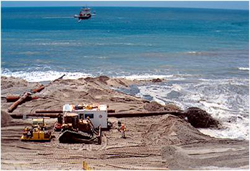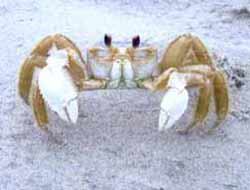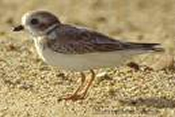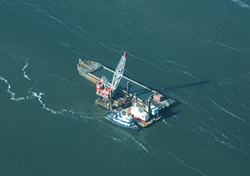Coastal Ocean Studies

The Environmental Research Section is involved in investigating and understanding human alterations in the coastal ocean. Two major areas of research are beach nourishment and ocean disposal of dredge material.
Beach Nourishment Studies
 As development of South Carolina’s coastline continues, erosion presents a major problem especially
on our barrier islands which support valuable residential properties and a large portion of the state’s
tourism industry. Beach nourishment, the placement of sand onto eroding beaches, provides protection for
beachfront property and restores the recreational value of beaches, but its impact on coastal ecosystems is
complex and varies depending on the animals and location. Environmental Research Section (ERS) staff have
monitored a number of beach nourishment projects (PDF)
since 1990 including projects on Folly Beach (1991, 2005, 2007), Hilton Head (1990, 1997, 2006, 2011) and
Myrtle Beach (1996, 2007). As an example, the “Study to evaluate
the effects of Beach Nourishment at Folly Beach” (PDF) began in May 2005 and was completed in
November 2006. Prior to dredging and nourishment, ERS staff sampled the bottom-dwelling communities living
within the sediments both at the offshore sand borrow areas (where dredging equipment collects sand) and on
the beach (where the sand is deposited). Borrow area sampling focused on characterizing the condition and
composition of the entire bottom-dwelling invertebrate community, whereas the beach surveys were confined to
ghost crabs and ghost shrimp. These efforts established a baseline for monitoring the recovery process within
the two habitats. Additional sampling was conducted after dredging and nourishment were completed to evaluate
the impacts and recovery rates of the organisms in both areas. Findings in this study and others have shown
that dredging and nourishment can have negative biological effects on offshore and beach communities.
Negative effects on the beach were generally short-term, with the exception of ghost crab populations near
the primary dune where decreasing abundances may be attributed to greater beach width. Dredging resulted in
longer term negative changes in sediment characteristics (the borrow pit filled with mud) and biological
communities in the borrow area where recovery to original condition was still not evident one year after
completion.
As development of South Carolina’s coastline continues, erosion presents a major problem especially
on our barrier islands which support valuable residential properties and a large portion of the state’s
tourism industry. Beach nourishment, the placement of sand onto eroding beaches, provides protection for
beachfront property and restores the recreational value of beaches, but its impact on coastal ecosystems is
complex and varies depending on the animals and location. Environmental Research Section (ERS) staff have
monitored a number of beach nourishment projects (PDF)
since 1990 including projects on Folly Beach (1991, 2005, 2007), Hilton Head (1990, 1997, 2006, 2011) and
Myrtle Beach (1996, 2007). As an example, the “Study to evaluate
the effects of Beach Nourishment at Folly Beach” (PDF) began in May 2005 and was completed in
November 2006. Prior to dredging and nourishment, ERS staff sampled the bottom-dwelling communities living
within the sediments both at the offshore sand borrow areas (where dredging equipment collects sand) and on
the beach (where the sand is deposited). Borrow area sampling focused on characterizing the condition and
composition of the entire bottom-dwelling invertebrate community, whereas the beach surveys were confined to
ghost crabs and ghost shrimp. These efforts established a baseline for monitoring the recovery process within
the two habitats. Additional sampling was conducted after dredging and nourishment were completed to evaluate
the impacts and recovery rates of the organisms in both areas. Findings in this study and others have shown
that dredging and nourishment can have negative biological effects on offshore and beach communities.
Negative effects on the beach were generally short-term, with the exception of ghost crab populations near
the primary dune where decreasing abundances may be attributed to greater beach width. Dredging resulted in
longer term negative changes in sediment characteristics (the borrow pit filled with mud) and biological
communities in the borrow area where recovery to original condition was still not evident one year after
completion.
 Beach modification of ocean shorelines can also significantly impact the quality of shorebird habitat and
may pose a serious threat for threatened/endangered shorebirds that use South Carolina’s coastal areas
for migratory stopover and overwintering habitat. The Environmental Research Section, in conjunction with
the US Fish and Wildlife Service, conducted a monitoring
study on Kiawah Island from 2006-2011 (PDF) which investigated whether prey availability for the piping
plover (Charadrius melodus) changed following a tidal inlet relocation and beach restoration project on the
Island. Results suggested that there was potentially a link between prey availability in the area and
declines in the overwintering piping plover population. A similar study is currently underway on Hilton
Head Island where a terminal groin was constructed adjacent to a US Fish & Wildlife designated
Critical Habitat Area (PDF)
used as overwintering habitat by piping plovers and other shorebirds.
Beach modification of ocean shorelines can also significantly impact the quality of shorebird habitat and
may pose a serious threat for threatened/endangered shorebirds that use South Carolina’s coastal areas
for migratory stopover and overwintering habitat. The Environmental Research Section, in conjunction with
the US Fish and Wildlife Service, conducted a monitoring
study on Kiawah Island from 2006-2011 (PDF) which investigated whether prey availability for the piping
plover (Charadrius melodus) changed following a tidal inlet relocation and beach restoration project on the
Island. Results suggested that there was potentially a link between prey availability in the area and
declines in the overwintering piping plover population. A similar study is currently underway on Hilton
Head Island where a terminal groin was constructed adjacent to a US Fish & Wildlife designated
Critical Habitat Area (PDF)
used as overwintering habitat by piping plovers and other shorebirds.
Ocean Disposal Area Studies
 An essential practice to construct and maintain navigational channels and ports is to remove and relocate
sediments. Dredging and disposal of dredged sediments are among the most important activities affecting
valuable wetlands, estuaries and associated fisheries along the coastal areas of the United States. Dredge
material can be placed on land or in the ocean. Ocean disposal of dredged material is only permitted at
Ocean Dredged Material Disposal Sites (ODMDS) which are designated by the US Environmental Protection
Agency. Placement of these sites is critical to ensure that no living hard bottom habitats are impacted.
There are several ODMDS’s along US coastlines designated to receive dredged materials from approved
projects. Many of these areas are not closely monitored and remain largely unstudied in the effects they
have on the surrounding seafloor. The ODMDS in Charleston, South Carolina, is a repository for uncontaminated
sediments dredged from Charleston Harbor shipping and entrance channels. A monitoring program of the physical
and biological condition of bottom habitats within and surrounding the Charleston ODMDS was completed after the
conclusion of disposal activities associated with the 1999-2002
Charleston Harbor Deepening Project (PDF). The placement of disposal material into the Charleston ODMDS
from the Charleston Harbor Deepening Project, and from ongoing maintenance dredging, has resulted in a number
of physical and biological impacts to the areas surrounding the disposal zone, as well as anticipated impacts
within the disposal area.
An essential practice to construct and maintain navigational channels and ports is to remove and relocate
sediments. Dredging and disposal of dredged sediments are among the most important activities affecting
valuable wetlands, estuaries and associated fisheries along the coastal areas of the United States. Dredge
material can be placed on land or in the ocean. Ocean disposal of dredged material is only permitted at
Ocean Dredged Material Disposal Sites (ODMDS) which are designated by the US Environmental Protection
Agency. Placement of these sites is critical to ensure that no living hard bottom habitats are impacted.
There are several ODMDS’s along US coastlines designated to receive dredged materials from approved
projects. Many of these areas are not closely monitored and remain largely unstudied in the effects they
have on the surrounding seafloor. The ODMDS in Charleston, South Carolina, is a repository for uncontaminated
sediments dredged from Charleston Harbor shipping and entrance channels. A monitoring program of the physical
and biological condition of bottom habitats within and surrounding the Charleston ODMDS was completed after the
conclusion of disposal activities associated with the 1999-2002
Charleston Harbor Deepening Project (PDF). The placement of disposal material into the Charleston ODMDS
from the Charleston Harbor Deepening Project, and from ongoing maintenance dredging, has resulted in a number
of physical and biological impacts to the areas surrounding the disposal zone, as well as anticipated impacts
within the disposal area.
Additionally, to determine if migrating sediments were negatively affecting invertebrate and/or fish communities at reef areas around the disposal area, a comprehensive study involving scientists from SCDNR, Coastal Carolina University, and the University of Georgia monitored three study sites and three reference sites proximal to the disposal area biannually from 2000-2005. The results of this study (PDF) suggest that surficial sediment depths and changes observed in grain size at sites do not appear to be related to movement of sediments from the disposal area. The trends observed in the hard bottom reef communities in the vicinity of the disposal site do not indicate that reef fishes or invertebrate communities have been negatively affected by disposal activities. However, this study started after disposal activities had already begun, and impacts might have happened before sampling. The Environmental Research Section will continue to be involved with activities to evaluate the effects of open water disposal of sediments, as the DNR has recommended some additional monitoring of the disposal site to evaluate longer-term impacts. New plans to deepen Charleston Harbor to accommodate “Post-Panamax” ships will require both an expansion of the current ODMDS, and the placement of large quantities of new material offshore. ERS staff will be working closely with the Corps and other agencies to design and monitor this activity.
Program Coordinator:
Dr. Denise Sanger
Phone: 843-953-9074
Some of the files above are in the Adobe PDF file format. Adobe® Reader® is required to open
the files and is available as a free download from the Adobe®
Web site.
